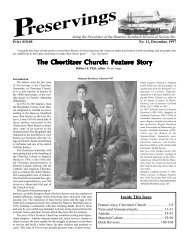Preservings $20 Issue No. 26, 2006 - Home at Plett Foundation
Preservings $20 Issue No. 26, 2006 - Home at Plett Foundation
Preservings $20 Issue No. 26, 2006 - Home at Plett Foundation
Create successful ePaper yourself
Turn your PDF publications into a flip-book with our unique Google optimized e-Paper software.
The history of Mennonites in Amsterdam is<br />
the 1 history of a large, urban congreg<strong>at</strong>ion loc<strong>at</strong>ed<br />
in Holland’s largest and chief city. In spite<br />
of its situ<strong>at</strong>ion it must be said th<strong>at</strong> the church has<br />
remained intact for more than four centuries and<br />
has always counted its members by the thousands.<br />
It is today the largest Mennonite congreg<strong>at</strong>ion in<br />
existence and no doubt always has been so.<br />
“The United Mennonite Congreg<strong>at</strong>ion of<br />
Amsterdam” as the church is called, is loc<strong>at</strong>ed<br />
<strong>at</strong> Singel 452 in a historic part of the city. This<br />
church building was erected in 1608 and enlarged<br />
in 1632 by the prominent merchant Warendorf,<br />
who lived <strong>at</strong> Singel 454 which is now the janitor’s<br />
dwelling. At his de<strong>at</strong>h he don<strong>at</strong>ed the building to<br />
the Flemish Mennonite congreg<strong>at</strong>ion.<br />
This old church was built as a “hidden”<br />
church, th<strong>at</strong> is, it was erected between two street<br />
fronts <strong>at</strong> a time when Mennonites were not allowed<br />
to publicize their church life. The simple<br />
and sober architecture, as we11 as a rectangular<br />
floor-plan with the pulpit in the middle of the long<br />
side, is a reminder of early Mennonitism.<br />
This original Mennonite meetinghouse of the<br />
Flemish Mennonites design<strong>at</strong>ed “near the Lamb”<br />
because it was loc<strong>at</strong>ed near a brewery which bore<br />
the sign of a lamb, has been preserved throughout<br />
the centuries and remains today the center<br />
of Mennonite life<br />
not only in Amsterdam,<br />
but for<br />
a11 of Ho11and.<br />
However, it has<br />
not always been<br />
so, and there were<br />
in the seventeenth<br />
century more than<br />
a score of Mennonite<br />
groups with<br />
eleven different,<br />
places of meeting.<br />
To understand this<br />
it is necessary to<br />
refer a bit to the<br />
earlier history of<br />
the Mennonites in<br />
Amsterdam.<br />
In the sixteenth<br />
century Mennonite<br />
world many roads<br />
led to Amsterdam.<br />
The city was becoming<br />
a kind of<br />
“melting pot” for<br />
many kinds of both<br />
foreign and n<strong>at</strong>ive<br />
Mennonites. Typical<br />
of this immigr<strong>at</strong>ion<br />
was Nicolaes<br />
Biestkens, a Mennonite<br />
printer<br />
from Emden, who<br />
moved his press<br />
via Harlingen to<br />
Amsterdam, or the<br />
Mennonites in Amsterdam<br />
Irwin B. Horst (Reprinted with permission from Mennonite Life 7, July 1952, 113-115)<br />
Vondel family from Antwerp who arrived by way<br />
of Cologne and Bremen. Amsterdam received its<br />
share of the many refugees from the south who<br />
were fleeing from persecution in Brabant and<br />
Flanders. Thus the stage was set for Amsterdam,<br />
r<strong>at</strong>her than Antwerp or Emden, to become a leading<br />
center of Mennonite life in the seventeenth<br />
and eighteenth centuries.<br />
However, it must not be thought th<strong>at</strong> the congreg<strong>at</strong>ions<br />
in Amsterdam were composed only<br />
of a Mennonite dispersion. From the beginning<br />
of the Anabaptist movement in thc Netherlands<br />
there was a strong indigenous brotherhood in Amsterdam.<br />
Jan Trijpmaker, an apostle of Melchior<br />
Hoffman, came from Emden in 1530 and was<br />
l<strong>at</strong>er followed by Hoffman himself. It is known<br />
th<strong>at</strong> by 1533 there were already three to five<br />
thousand Anabaptists in the city. When Jan van<br />
Leyden ca11ed his faithful to Münster in 1534,<br />
the authorities stopped twenty-one bo<strong>at</strong>s on the<br />
Zuiderzee containing three thousand Anabaptists<br />
who were mostly from Amsterdam.<br />
The Münster aberr<strong>at</strong>ion had its effect not<br />
only on the Anabaptists in Amsterdam but also<br />
on the city authorities, and both revolutionary<br />
and peaceful groups were mercilessly persecuted.<br />
Jacob van Campen, the leader of the peaceful<br />
element, was executed. Hundreds were tortured<br />
Interior of the Singelkerk Mennonite meetinghouse in Amsterdam. (Credit: Jan Gleysteen)<br />
and put to de<strong>at</strong>h in the city. The town square<br />
(the Dam) is holy ground for Mennonites, and<br />
the most of the city on the west side near the Ij<br />
became known as the “martyr’s mo<strong>at</strong>” (Martelaarsgracht)<br />
because of the many bodies thrown<br />
into the w<strong>at</strong>er there.<br />
A Memorial of the Singel Mennonite Church, Amsterdam<br />
<strong>Preservings</strong> <strong>No</strong>. <strong>26</strong>, <strong>2006</strong> - 29
















